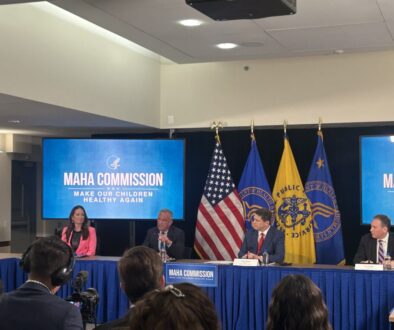Wide variety of pesticides found in baby foods sold at major retailer
By Douglas Main
Samples of puréed apple and pear baby food sold online and at Target stores in San Francisco, Washington, DC and Minneapolis were found to contain a wide variety of pesticides, according to a new report by an environmental group.
All eight samples of the baby food products, which are made by the popular retail store’s house brand, Good & Gather, contained a class of chemicals called neonicotinoids, according to the study published this week, which was conducted by the nonprofit Friends of the Earth and has not been peer-reviewed. These pesticides are widely used in agriculture and considered toxic to insects such as honeybees. Evidence is accumulating that they may also have various negative effects on human health.
The neonicotinoids detected include imidacloprid, present in half of the pear products, and thiacloprid, present in 75% of the apple purée samples. Both are considered “highly hazardous pesticides” by the Pesticide Action Network, and each are banned for outdoor use in the European Union due to their toxicity, including to pollinators like bees.
The European Food Safety authority has stated that thiacloprid “is likely to damage fertility and the unborn child.”
Target didn’t directly respond to questions but said in a written statement that it is “committed to providing guests with safe, high-quality products. Our baby food offerings meet all regulatory requirements and are safe for consumption.”
Nathan Donley, a scientist who studies pesticides with the Center for Biological Diversity but wasn’t involved in the report, said the results show the regulators are failing to keep food safe, especially for infants.
“To see neurotoxins in children’s food, at any level, is unacceptable in my opinion,” he said. “Every child has different susceptibilities and sensitivities – the idea that a certain level of a poison is safe for every individual is outdated thinking.”
The Environmental Protection Agency (EPA) has not done much research on the impacts of mixtures of pesticides on human health, said Donley. Usually, the science addresses impacts of one chemical, and often that data is limited to large or one-time exposures.
“As you can see from this study and many others, pesticide mixtures are the rule, not the exception,” Donley said. “There’s a presumption of safety in the U.S. when it comes to food on store shelves. Unfortunately, with chemical agriculture run amok in this country, that presumption is often misplaced.”
The EPA did not respond to requests for comment in time for publication.
In their analysis, the researchers also discovered remnants of organophosphate pesticides in all samples tested. Organophosphates are generally classified as highly toxic, and many of the chemicals these pesticides break down into, called metabolites, are known neurotoxins that can impair brain development and function.
In all, the report found small concentrations of 16 pesticides in the apple products and 17 pesticides in the pears. Eight of the chemicals are restricted or banned in the European Union due to their toxicity. These concentrations detected were all below the legally mandated level for pesticides in food in the United States, known as the maximum residue level, but would run afoul of the law in the European Union for some of the chemicals.
The pear products contained an average of four parts per million of the organophosphate metabolites, according to the report; the apples contained about one-fourth as much.
Earlier this month, the Food and Drug Administration (FDA) issued its most recent pesticide residue monitoring report, disclosing that pesticide residues were found in 57.3% of food samples from domestic suppliers, and in 55.4% of imported food samples. The agency said that most – 96.2% of domestic and 89.5% of imported – food samples showed residue levels that fell within legal limits. The agency analyzed 2,800 human foods for the 2022 report, made up of 731 domestic samples and 2,069 import samples.
Imidacloprid was the third most prevalent pesticide found in the samples, according to the FDA report.
US regulators maintain that pesticide residues in food are generally not a threat to human health if they fall within legal limits set for specific foods and specific pesticides. But a growing number of researchers argue that these legally allowed limits, known as maximum residue limits (MRLs), are not stringent enough to protect human health, especially for babies with developing brains and small bodies.
A May study by Consumer Reports found that one-fifth of the foods examined, including bell peppers, blueberries, green beans, potatoes and strawberries, contained pesticide residues at levels that posed “significant risks” to consumers. Two-thirds of tested food had levels of pesticides that present little to no risk to health.
Animal studies show that some of the neonicotinoids and organophosphates have neurotoxic properties. These chemicals may also harm human health, for example by interfering with brain development or the proper function of the body’s endocrine system, said Kendra Klein, lead author of the Target baby food report and a researcher with Friends of the Earth.
“It’s really alarming to find these in food that’s meant for babies,” said Klein. These chemicals “just shouldn’t be there,” she added.
Research shows that when people switch to organic diets, the levels of pesticides found in the body decrease, often quickly, Klein said. Eating food with lower quantities of pesticides is almost certain to have various health benefits, research suggests.
(Featured Image by Rachel Loughman on Unsplash.)




